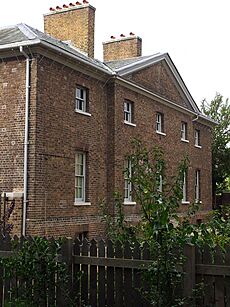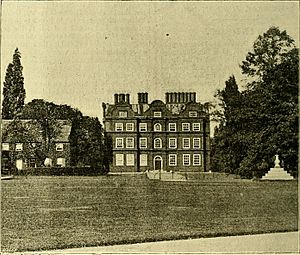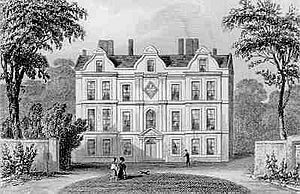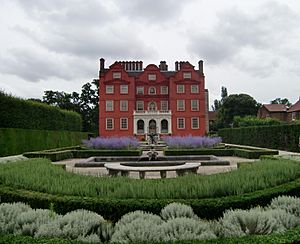Kew Palace facts for kids
Quick facts for kids Kew Palace |
|
|---|---|
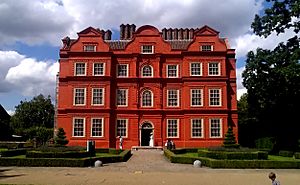
The Dutch House, one of the few surviving parts of the Kew Palace complex
|
|
| Type | Palace |
| Location | Kew Gardens |
| OS grid reference | TQ 18482 77474 |
| Area | London Borough of Richmond upon Thames |
| Built | 1631 |
| Architectural style(s) | Artisan Mannerist |
| Governing body | Historic Royal Palaces |
|
Listed Building – Grade I
|
|
| Official name: Kew Palace | |
| Designated | 10 January 1950 |
| Reference no. | 1263073 |
| Lua error in Module:Location_map at line 420: attempt to index field 'wikibase' (a nil value). | |
Kew Palace is a royal palace located inside Kew Gardens. It sits right by the River Thames in London. Once, it was a very large group of buildings. Today, only a few parts of it are still standing.
The main building that remains is called the Dutch House. It was built in 1631 on top of an older building's foundation. The royal family used the Dutch House from about 1728 until 1818. It was briefly used again in 1844.
The Dutch House is a very important historic building, given a Grade I listing. It is open for people to visit. A special charity called Historic Royal Palaces looks after it. This charity does not get money from the government or the Royal Family.
Next to the Dutch House, you can see part of its old service wing from the 1700s. Nearby are other buildings like a former housekeeper's house, a brewhouse, and a kitchen block. Most of these are private homes. However, the old kitchens are open to the public. Historic Royal Palaces also manages these kitchens, along with the Great Pagoda and Queen Charlotte's Cottage.
Contents
History of Kew Palace
Early Buildings and the Dutch House
Underneath the Dutch House, there are parts of a building from the 1500s. This land once belonged to John Dudley. It was later given back to his son, Robert Dudley, 1st Earl of Leicester. Robert Dudley was a childhood friend of Elizabeth I. He entertained Queen Elizabeth at a house in Kew in 1563.
In 1619, Samuel Fortrey leased the old building. He tore down most of it in 1631, leaving only the foundation. Then, he built a new, larger house facing south. This new house became known as the Dutch House.
The name "Dutch House" came from a misunderstanding about Samuel Fortrey's family. It also came from the house's style of architecture. This style, called Artisan Mannerist, had special "Dutch gables" on the roof. However, this style was actually more common in London and parts of England than in the Netherlands. In 1697, Fortrey's family leased the house to Sir Richard Levett. He was a powerful merchant and a former Lord Mayor of London.
The White House at Kew
Across from the 1631 Dutch House was another large house. This mansion might have been built during the Tudor period. The famous diarist John Evelyn often visited it. This house later belonged to Elizabeth, who was married to Prince of Wales's secretary, Samuel Molyneux.
This mansion was also where James Bradley made important observations in 1725. His work led to his discovery of the aberration of light. The house was eventually torn down in 1802. In 1832, William IV placed a special sundial to mark the spot of Bradley's observations. This sundial was later replaced with a copy in 1959.
Royal Children at Kew

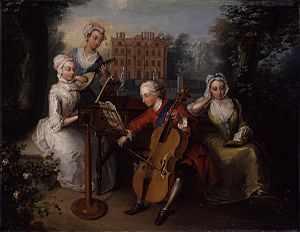
In 1727, Queen Caroline and George II became the King and Queen. They had six children living with them at their summer home, Richmond Lodge. In 1728, Queen Caroline leased the Dutch House. She wanted it for her three oldest daughters: Anne, Amelia, and Caroline.
Their eldest son, Frederick, came to Britain in December 1728. He was 21 years old and wanted to get to know his sisters. He soon leased the old Capel House at Kew. In 1731, he bought everything inside it. Frederick then started to redesign the house with help from William Kent. It became known as the White House because of its white plastered outside.
Frederick also added a large, separate kitchen building. These kitchens are now open to the public as 'the Royal Kitchens' since 2012. There was also a stable building for the White House, but it was torn down in the late 1800s.
A painting from 1733 shows Frederick and his three oldest sisters playing music. It was painted by Philip Mercier. Two versions of this painting show the Dutch House in the background. The White House became Frederick's main country home for his family. He entertained famous poets there, like James Thomson and Alexander Pope. In 1738, Pope gave Prince Frederick a dog. The dog's collar had a famous verse: I am His Highness' dog at Kew. Pray tell me, sir, whose dog are you?
Augusta and King George III

In 1751, Frederick caught a chill and sadly passed away. His wife, Augusta, continued to live at the White House with their children. She also kept working on the gardens. She got advice from her husband's friend, John Stuart, 3rd Earl of Bute. Sir William Chambers, a great garden designer, also helped her.
Frederick's sister Amelia likely lived in the Dutch House until 1751. She then moved to White Lodge in Richmond Park. This meant the Dutch House could become a school for Augusta's two oldest sons. These were George (who would become George III) and Edward. They were taught by Bute and Chambers.
In 1760, George became King. A year later, he married Charlotte of Mecklenburg-Strelitz. They had fifteen children between 1762 and 1783. Chambers built the Orangery and the Great Pagoda at Kew for Augusta in 1761–62.
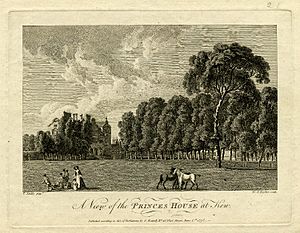
Augusta kept the Dutch House and White House until she passed away in 1772. Then, they went to King George III. He tore down Richmond Lodge and made the White House his summer home. He also kept some of his art collection there.
George III continued to use the Dutch House as a school. Now, it was for his two oldest sons, George and Frederick. Because of this, it was sometimes called 'the Prince of Wales's House'. The royal governess, Lady Charlotte Finch, lived nearby. A painting from around 1771–72 shows her with some of the royal children in the Dutch House gardens.
The royal family only leased the buildings and grounds until 1781. On October 13, 1781, George III bought the land from the Levetts for £20,000. Seven years later, George III stayed in the White House during a period of illness from November 1788 to March 1789. His wife, Queen Charlotte, and their daughters lived on the upper floors.
The White House then started to fall apart. However, it was still used to house the King during another period of illness in 1801. Queen Charlotte and her daughters moved into the Dutch House at that time. The White House was finally torn down in 1802. So, during a third period of illness in 1804, King George was housed in an improved service wing of the Dutch House. Queen Charlotte and the princesses stayed on the first and second floors of the Dutch House.
A New Palace and Its Demise
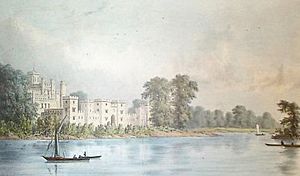
After the White House was torn down, plans for a new palace began around 1800. This new building was called the Castellated Palace, or New Kew Palace. The Dutch House was then often called the Old Palace or the Old Red House.
George III chose James Wyatt as his architect. The new palace was built in the neo-Gothic style. The King himself was very involved in the design. However, his illnesses in 1801 and 1804 caused many delays and cost overruns. The new palace was not very popular. People criticized its design, saying it looked like a prison.
King George III visited Kew for the last time in 1806 to see the new palace. He never returned to Kew after that. The Dutch House was refitted in 1809 for his youngest daughter, Princess Amelia. She wanted to move there to recover from her illness. However, her parents did not allow it. She stayed at Windsor and passed away in 1810. This event likely caused the King's final period of illness.
This last period of illness meant that work on the Castellated Palace stopped for good. It was left as a mostly roofed shell. King George III was confined at Windsor for ten years. In 1818, Queen Charlotte was traveling to Windsor to see the King. She decided to stop at the Dutch House for a few days. She was ill and could not continue her journey. So, two royal weddings took place in the Dutch House drawing room on July 11, 1818. Later that year, on November 17, Queen Charlotte passed away in her bedroom on the first floor of the building.
King George III passed away in 1820. His son, George IV, decided to tear down the Castellated Palace. Parliament agreed to this decision. Any parts that had been installed in the new palace were moved to other royal homes. For example, its staircase was later used at Buckingham Palace.
Kew Palace Opens to the Public

George IV also planned to tear down the Dutch House, but this did not happen. His brother, William IV, asked for plans to add a west wing to it. He wanted to bring it back into use, but this also did not happen. William IV offered the Dutch House to his sister-in-law, Victoria, Duchess of Kent. She was the mother of the future Queen Victoria. However, she turned it down, saying it was "an old house quite unfit for the princess and me."
Queen Victoria briefly sent three of her own children there in the summer of 1844. But the next year, she and Prince Albert started to remodel Osborne House as their summer home. The Dutch House remained empty until 1898. That year, Queen Victoria gave it and Queen Charlotte's Cottage to Kew Gardens. This was to celebrate her Diamond Jubilee. By this time, most of the palace's stables and service wing had been torn down. A copy of a 1600s Dutch garden was added behind the house in 1969.
The Dutch House was open to the public until 1996. Then, a big restoration project began. This included fixing the building and creating new curtains and fabrics. An outside lift was added to the west wing for people with disabilities.
The building was used for a special dinner hosted by Charles, Prince of Wales, to celebrate Queen Elizabeth II's 80th birthday on April 21, 2006. A few days later, it reopened as a place for visitors. The Palace was shown in a 2006 BBC TV show called Tales from the Palaces. Today, Historic Royal Palaces runs Kew Palace. They also manage the Royal Kitchens, which reopened in 2012, and the Pagoda, which reopened in 2018.
See also
 In Spanish: Palacio de Kew para niños
In Spanish: Palacio de Kew para niños


